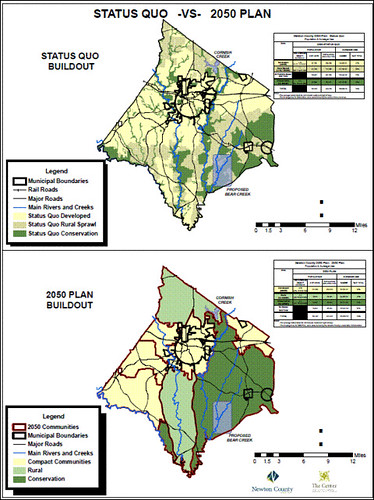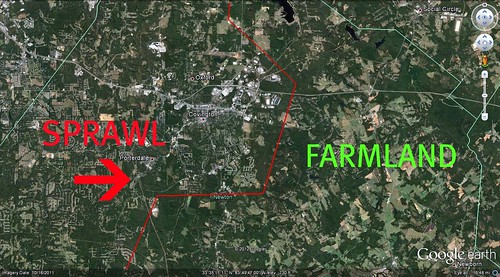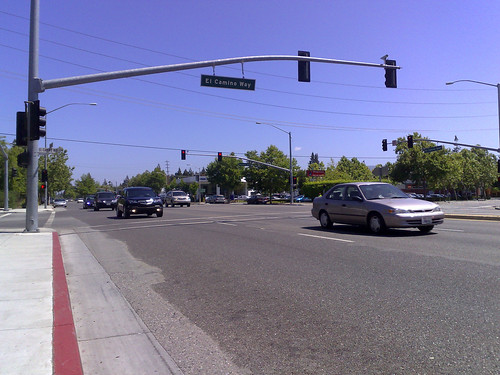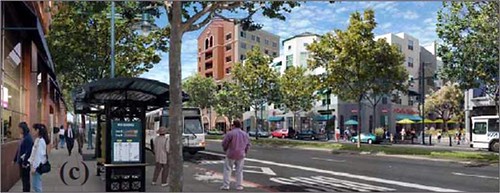Can collaboration substitute for authority in solving regional problems?

Posted May 1, 2012 at 1:24PM
As elaborated in yesterday’s post, metropolitan regions may well be the economic engines that drive America, and they may be one of the most significant scales (along with neighborhoods) for addressing environmental challenges. But they can be jurisdictional and administrative nightmares, making it challenging at best to address important economic, social, and environmental issues.
Given the all-too-apparent weaknesses of our local governments’ crazy-quilt legal “structure,” some metro areas - or parts of metro areas - are coming together voluntarily in issue-specific collaborations to get things done.
One great example is the Leadership Collaborative established by several municipalities and the county government in Newton County, Georgia, to come to grips with the ever-outward expansion of metropolitan Atlanta. As I wrote late last year, the population of the county - 30 miles from Atlanta - has doubled within the last two decades and is expected to double again in the next two. The rural and small-town character of the county so cherished by its residents has already been eroded and is in danger of being eradicated.
 I won’t repeat all that I wrote before, but the cities of Covington, Oxford, and Porterdale, the town of Newborn, and the Newton County Board of Commissioners, Water and Sewerage Authority, and School System - with support from the Covington-Newton County Chamber of Commerce and The Center for Community Preservation and Planning - have united in a remarkable collaborative effort to create a culture of forward-looking planning and cooperation in place previously not distinguished by much of either, in large part because it wasn’t needed.
I won’t repeat all that I wrote before, but the cities of Covington, Oxford, and Porterdale, the town of Newborn, and the Newton County Board of Commissioners, Water and Sewerage Authority, and School System - with support from the Covington-Newton County Chamber of Commerce and The Center for Community Preservation and Planning - have united in a remarkable collaborative effort to create a culture of forward-looking planning and cooperation in place previously not distinguished by much of either, in large part because it wasn’t needed.
The result is a shared commitment to direct growth into five planned compact communities, placing 88 percent of the future population on 30 percent of the county’s land. These communities will be walkable, with neighborhood schools and a mixture of uses. The open space and working farms in the rest of the county would be preserved for future generations. It’s a rich and inspiring story, and I’m impressed that the future vision was constructed not in a county planning office but by all of the municipalities - and, not insignificantly, their residents and constituents - working together. That dramatically increases the chances for successful implementation.
A second and very different example of municipalities working together to address common issues is the Grand Boulevard Initiative in California’s Silicon Valley, an attempt to transform one of the country’s most notorious commercial corridors. As stated on the Initiative’s website, “the Grand Boulevard is a collaboration of 19 cities, counties, local and regional agencies united to improve the performance, safety and aesthetics of El Camino Real,” the once-royal road connecting Spanish missions that has now largely devolved to a wide and frayed ribbon of highway filled with today’s Americana: parking lots, big boxes, strip malls, fast-food joints, faded businesses and the like.
There are exceptions along the way, but that’s the rule. Spots along the road with a sense of place are infrequent.
The Initiative addresses a 43-mile corridor covering Camino Real (State Route 82) and a half-mile on either side starting south of San Francisco in Daly City and stretching to central San Jose. Its purpose is to create that missing sense of place, and to do so with smart growth principles:
“The vision is of a boulevard that connects communities by a mix of land uses designed to attract people. Cities are encouraged to design for neighborhoods that include high quality building designs and diverse land uses, preserve historic buildings and places, and enhance our economic and cultural diversity, with the broad involvement of residents, workers and local businesses. Rail stations and bus facilities are valued not only as vital transportation services, but as public gathering places and assets to spur transit oriented development. Roadway improvements will be context sensitive while continuing to meet the need to move people and commerce and preserve environmental resources. Above all, change will recognize and incorporate our history and create a sense of community.”
This is a daunting and ambitious task, to say the least. The website’s description continues, emphasizing the inter-jurisdictional nature of the effort:
“Though many localized planning efforts are underway, they remain uncoordinated. For that reason, the San Mateo County Transit District (SamTrans), Santa Clara Transportation Authority (VTA), Joint Venture: Silicon Valley Network, San Mateo City/County Association of Governments (C/CAG), and SAMCEDA (San Mateo Economic Development Association) started an extensive program of collaboration, bringing together all of the agencies having partial responsibility for the street, for the first time in the history of El Camino . . .
“Technically the goal is to produce a coordinated series of policy decisions that will be embraced by all jurisdictions, thereby helping El Camino Real to function and look better. But the vision goes farther: the Grand Boulevard initiative seeks to recreate the street to do a better job of connecting our communities (north-south) and of better integrating it with each of our communities (east-west.).”
Neither the Initiative nor its Task Force holds legal authority. Indeed, officials of the Initiative describe it as a “coalition of the willing,” whose success will depend upon the consolidation and maintenance of the political resolve and economic resources necessary for each community to do its part along the corridor. Still, the initiative brings together for the first time all of the agencies having responsibility for the condition, use and performance of the street, along with almost all of the communities it touches. And there is no question that significant stretches of the corridor are ripe for redevelopment, so change is going to occur with or without a grand vision.
In the absence of a regional authority with control over land use, transportation and economic development, this may be the best alternative. At worst, it’s an ambitious start. Will it work? I hope so. Here’s a well-produced video that sums up the effort:
Related posts:
- Official review finds environmental benefits from additional homes near Silicon Valley jobs (December 15, 2011)
- The link between thriving towns and a sustainable rural landscape (March 18, 2011)
- "Cities" may not matter as much as we think - regions and neighborhoods are where things actually happen (November 1, 2010)
- Small town changes: “I watched the growth – it’s become ‘Paradise Lost’ for me” (March 16, 2010)
Move your cursor over the images for credit information.
Please also visit NRDC’s sustainable communities video channel.


